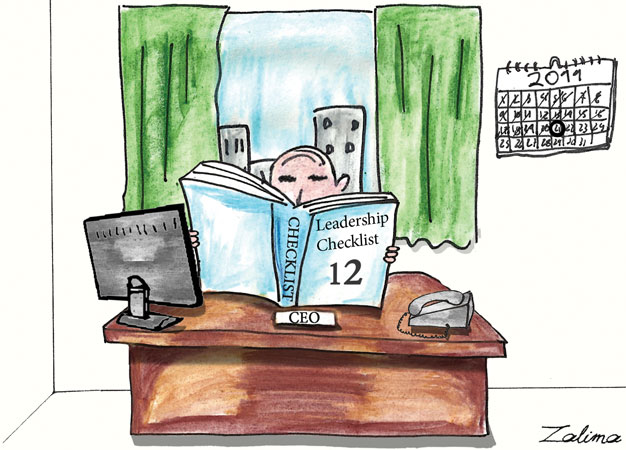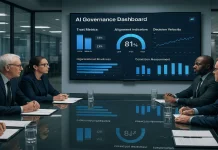The Leader’s Checklist comprises fifteen mission-critical, time-tested leadership principles that vary surprisingly little among companies or countries. Taken together, they constitute a playbook for leadership decisions whatever the challenge.
Imagine yourself in this position: Less than five months ago, you were summoned from the private sector to join a newly formed national government. Your background is in retail; now you are heading up the nation’s mining industry. You are abroad on a state visit, still working to come up to speed, when word reaches you from your home office that there has been a mining disaster – a cave-in deep below, death toll unknown, nearly three dozen missing.
Or envision this situation: For decades, your financial services firm has sailed along. Not only have revenues soared, your company has also earned a treasured AAA credit rating while creating an extraordinary wealth engine: a little giant of a division that insures against debt defaults, including subprime mortgages. Continuing prosperity seems predictable, but suddenly the market implodes. Subprime mortgages turn noxious. Lehman Brothers goes under. Your AAA rating slips to AA, then A-; and with the downgrades, you have to post billions of dollars in collateral that you simply do not have. This boat is sailing straight toward a roaring waterfall, and you are standing at the helm.
These are not, of course, hypothetical or anonymous events. Laurence Golborne, the new mining minister for the Republic of Chile, was visiting Ecuador on the night of August 5, 2010, when his chief of staff back in Santiago sent him a simple but urgent text message: “Mine cave-in Copiapó; 33 victims.” Twenty-eight hours later, at 3:30 a.m. on August 7, Golborne arrived at the remote site of the mining disaster in the Atacama desert of northern Chile. Soon, hundreds of millions of people around the globe would be witnessing one of the greatest mining rescues of all time.1
Like the miners in Chile, American International Group (AIG) – the financial services giant heading for the cataract – was ultimately rescued through direct government intervention. The company was deemed “too big to fail,” though it was almost too toxic to save. When the subprime mortgage market in which AIG was deeply invested began to collapse, top AIG executives had taken few protective measures. Their tone-deaf response to the tumultuous events that unfolded left the company vulnerable to one of the greatest corporate collapses in business history.2
One of the leaders we have just met was well prepared when summoned to moments of crisis. Others, recent history shows us, were obviously not. To be sure, few of us are likely to have our mettle tested in such trying circumstances. But all of us can and should prepare for less-public crises in our own spheres of serving, and thus it behooves us to ask: Why did Laurence Golborne rise so effectively to the challenge? Why were the AIG executives unable to steer an effective course? Is the skill set that served Golborne teachable, even transferable and applicable, to leaders who will never be called to scale the kinds of mountains these managers had to face?
Drawing on research and experience, I have concluded that effective leadership can be learned, and indeed should be learned, by those with responsibility for the performance of their enterprises and their employees. I have also found that leadership benefits from an approach built upon specific guiding principles that, taken together, create a clear road map for navigating any situation. That is why I have come to advocate the Leader’s Checklist, a complete set of vital leadership principles that are tried, tested and true.
Fifteen Core Principles
The principles of the checklist should be applicable to most leaders, in most endeavors, in most circumstances, whether investment banking, high technology, or public service; whether good times or bad; and regardless of company or country. But a checklist is only as good as its underlying foundation, and the foundation is only as solid as the materials and engineering that go into it.
From an array of investigators, researchers, thinkers, and practitioners; from development work with hundreds of managers and executives in leadership programs in Asia, Europe, North America, and South America; from research interviews with many managers in the United States and abroad; and from witnessing managers facing a range of critical moments, I have concluded that their thinking and experience point to a set of fifteen mission-critical leadership principles that vary surprisingly little among companies or countries.
I have also become convinced that with leadership, as with much else, brevity is the soul of wit. Albert Einstein once described the calling of modern physics as an effort to make the physical universe as simple as possible – but not simpler. The Leader’s Checklist is likewise at its best when it is as bare-bones as possible – yet not more so.
With these considerations in mind, here are the fifteen essential principles that taken together, I believe, constitute an irreducible checklist for leadership action:
Customizing the Leader’s Checklist
While the fifteen principles provide a solid template for action, suitable for most leadership moments at most organizations at most times, “most” is not always good enough. Customized checklists are required for distinct contexts, and among the most important divisions are those of company, role, and country.
Company. Every organization requires its own customized set of checklist principles. In recent years, many of the largest have established such lists.
The Leader’s Checklist for General Electric, according to those highly familiar with the company, would include, for instance, teaching others how to lead their divisions, making tough – often wrenching – personnel decisions around performance, and continually innovating. A checklist for Google, by contrast, would place greater emphasis on pursuing individual creative sparks, keeping teams small, and guiding others in an even-keeled manner. A checklist for a major professional services firm might identify nearly a dozen special capacities that it holds to be vital for its managers, including seeing the world through its clients’ eyes, enthusiastically engaging with clients, and working with them to transcend conventional thinking.3
Role. Distinct positions necessitate their own unique additions to the core Leader’s Checklist. The customized principles for top executives are different from those for frontline managers. They, in turn, are different from those for company directors.
In interviewing more than a hundred company executives and institutional investors – part of a study of how the two work together or are sometimes at odds with each other – I found a special demand for chief executives to build personal familiarity with their largest investors, articulate a compelling vision for where the company was going and a persuasive strategy for getting there, and generate steady quarterly and annual growth in company earnings. In a separate study of company directors, a professional colleague and I learned that many directors place a premium on partnering with – not just monitoring – management, establishing clear lines between decisions retained by the board and those delegated to management, and taking an active role in setting company strategy.4
Country. Specific principles are essential for varied national locations as well. What is required in Argentina or Great Britain is at least partially distinct from what is essential in America or France.
This can be seen in the findings of the study of leadership styles in 67 countries. Working to engage rather than just instruct others drew high marks in countries such as the United States. By contrast, a greater premium is placed on indirect forms of communication through metaphors, parables, and the like in China.5
In pursuit of such customized principles for leading business in India, three colleagues and I interviewed senior executives at 100 of the largest 150 Indian publicly traded companies. Among our interviewees was R. Gopalakrishnan who oversees Tata Group, India’s largest company in market capitalization, with interests in automobiles, communication, consulting, hotels, power, steel, and tea.
For the Indian manager, Gopalakrishnan observed, “his intellectual tradition, his y axis, is Anglo-American,” but “his action vector, his x axis, is in the Indian ethos.” Many “foreigners come to India,” he said, “they talk to Indian managers, and they find them very articulate, very analytical, very smart, very intelligent. And then they can’t for the life of them figure out why the Indian manager can’t do something about [the plan] as prescribed by the analysis.” Indian business leaders, he concluded, “think in English” but “act Indian.”
Our fifteen core leadership principles are much the same in both the United States and India, we have found, and I believe that they are essential for running business firms in all major economies. Company leaders everywhere emphasize company strategy and motivating the work force, both on the y axis. Yet our study of Indian executives also revealed that they generally embraced several distinctive principles, all on an x axis, constituting a kind of “India Way” for leading business on that subcontinent. Indian business leaders, for instance, place special emphasis on personal values, a vision of growth, and strategic thinking. They take particular pride in not only enterprise success but also family prosperity, regional advance, and national renaissance.6
Activating the Leader’s Checklist
Medical centers often require physicians to run through a specific checklist before commencing surgery. Aviation authorities around the globe require the same of pilots before takeoff. Indeed, in many newer jetliners, a commercial pilot is not given full access to the controls until the checklist process has been electronically confirmed. To be sure, mistakes still get made on the runway and in the operating room, sometimes horrible ones, but since every item on each of these lists is critical, mandating them all is a sensible guarantee against missing any, as Atul Gawande’s The Checklist Manifesto and recent research have made clear.7
How surprising, then, that those in leadership positions often fail to require the equivalent of themselves. We take for granted a pilot’s thoroughness, or a surgeon’s, but we too often give ourselves a pass on reviewing an analogous list, or merely having one to check, even when we are facing moments during which a complete leadership inventory might be essential for sensibly directing or even saving the enterprise.
If executive compensation could somehow be directly linked both to creating a personalized Leader’s Checklist and routinely applying it – in the same way pilots have to move through a checklist before being allowed to proceed to the next phase of flight – we could expect to see fewer botched takeoffs and fewer midflight failures in the corporate arena. But with no comparable authority or device insisting on the Leader’s Checklist, the enterprising manager must enforce one’s own compliance.
For application to occur, however, managers must work to overcome a host of predictable but preventable behavioral lapses. One of the most important is that of knowing what should be done but then failing to do it, what researchers Jeffrey Pfeffer and Robert Sutton have termed the “knowing-doing gap.” Even the best checklist has no value unless it is routinely activated to guide a leader’s behavior. Doing so for many managers is an acquired rather than a natural skill.8
To close the critical knowing – doing gap, six learning avenues have proven especially valuable: self-directed study of leadership moments, coaching and mentoring, stretch experiences, after-action review of personal leadership moments, experience with extremely stressful leadership moments, and observing the leadership moments of others.
Organizational leadership has its greatest impact in times of uncertainty and change. When markets are predictable, when change is not in the offing, leaders can coast, at least for a while. It is when uncertainty becomes the norm and turbulence more commonplace that a Leader’s Checklist becomes most consequential and the six learning avenues become more essential – a time, that is, much like the present.
A checklist for leaders is certainly no substitute for comprehension and judgment, any more than the pilot’s or surgeon’s checklist is for flying a plane or operating on a patient successfully. The Leader’s Checklist is meant to simply be a trigger, and for that purpose, simplicity is essential, as is completeness. Application then depends entirely upon the owner’s commitment to generate and then use the checklist at a time when it will make a difference.
Adapted from The Leader’s Checklist, by Michael Useem (© 2011).
About the author
Michael Useem is Professor of Management and Director of the Center for Leadership and Change Management at the Wharton School of the University of Pennsylvania. His university teaching includes MBA and executive-MBA courses on leadership and change, and he offers programs on leadership, teamwork, governance, and decision making for managers in the United States, Asia, Europe, and Latin America. He also works on leadership development and governance with many companies and organizations in the private, public and non-profit sectors. He is the author of The Leader’s Checklist; The Leadership Moment; Investor Capitalism; and The Go Point: When It’s Time to Decide. He is also co-author and co-editor of Learning from Catastrophes, and co-author of The India Way: How India’s Top Business Leaders Are Revolutionizing Management. He can be reached at [email protected].
Notes
1. Michael Useem, Rodrigo Jordán, and Matko Koljatic, “How to Lead During a Crisis: Lessons from the Rescue of the Chilean Miners,” MIT Sloan Management Review, 53, Fall, 2011, 1-7 (http://sloanreview.mit.edu/x/53106); Matko Kojaltic, Rodrigo Jordan, and Michael Useem, “Leading the Rescue of the Miners in Chile,” Wharton School, University of Pennsylvania, and School of Business Administration at Pontificia Universidad Católica de Chile, 2011 (http://kw.wharton.upenn.edu/wdp/files/2011/07/Leading-the-Miners-Rescue.pdf).
2. Michael Useem, “Developing Leadership to Avert and Mitigate Disasters,” in Learning from Catastrophes: Strategies for Reaction and Response, edited by Howard Kunreuther and Michael Useem, Pearson Education, 2010.
3. See, for instance, Noel Tichy, The Leadership Engine: How Winning Companies Build Leaders at Every Level, HarperCollins, 1997; Adam Bryant, “Google’s Quest to Build a Better Boss,” New York Times, March 12, 2011; Jay William Lorsch and Thomas J. Tierney, Aligning the Stars: How to Succeed When Professionals Drive Results, Harvard Business School Press, 2002.
4. Michael Useem, Investor Capitalism: How Money Managers Are Changing the Face of Corporate America, Basic Books/HarperCollins, 1996; Michael Useem, “How Well-Run Boards Make Decisions,” Harvard Business Review, November 2006, 130–38; Michael Useem and Andy Zelleke, “Oversight and Delegation in Corporate Governance: Deciding What the Board Should Decide,” Corporate Governance: An International Review 14, 2006, 2–12.
5. Robert J. House, Paul J. Hanges, Mansour Javidan, Peter W. Dorfman, and Vipin Gupta, eds., Culture, Leadership, and Organizations: The GLOBE Study of 62 Societies, Sage Publications, 2004.
6. Peter Cappelli, Harbir Singh, Jitendra Singh, and Michael Useem, The India Way: How India’s Top Business Leaders Are Revolutionizing Management, Harvard Business Press, 2010.
7. Atul Gawande, The Checklist Manifesto: How to Get Things Right, Holt, 2009; Eefje N. de Vries et al., “Effect of a Comprehensive Surgical Safety System on Patient Outcomes,” New England Journal of Medicine 363, 2010, 1928–37.
8. Jeffrey Pfeffer and Robert I. Sutton, The Knowing-Doing Gap: How Smart Companies Turn Knowledge Into Action, Harvard Business School Press, 2000.










